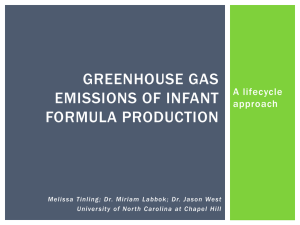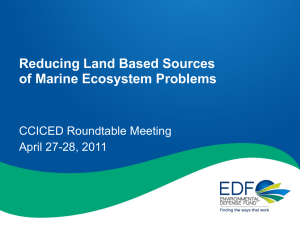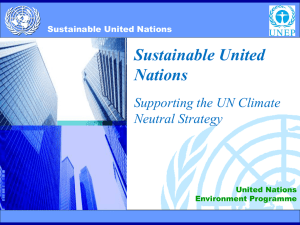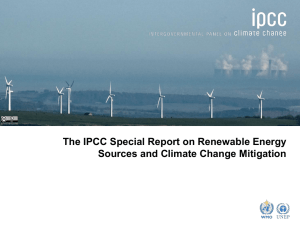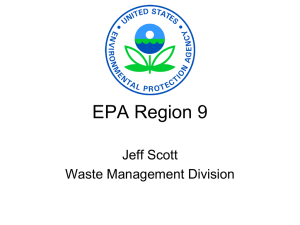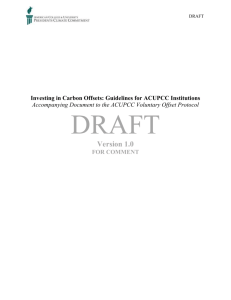ACUPCC Offset Project – Key Issues
advertisement
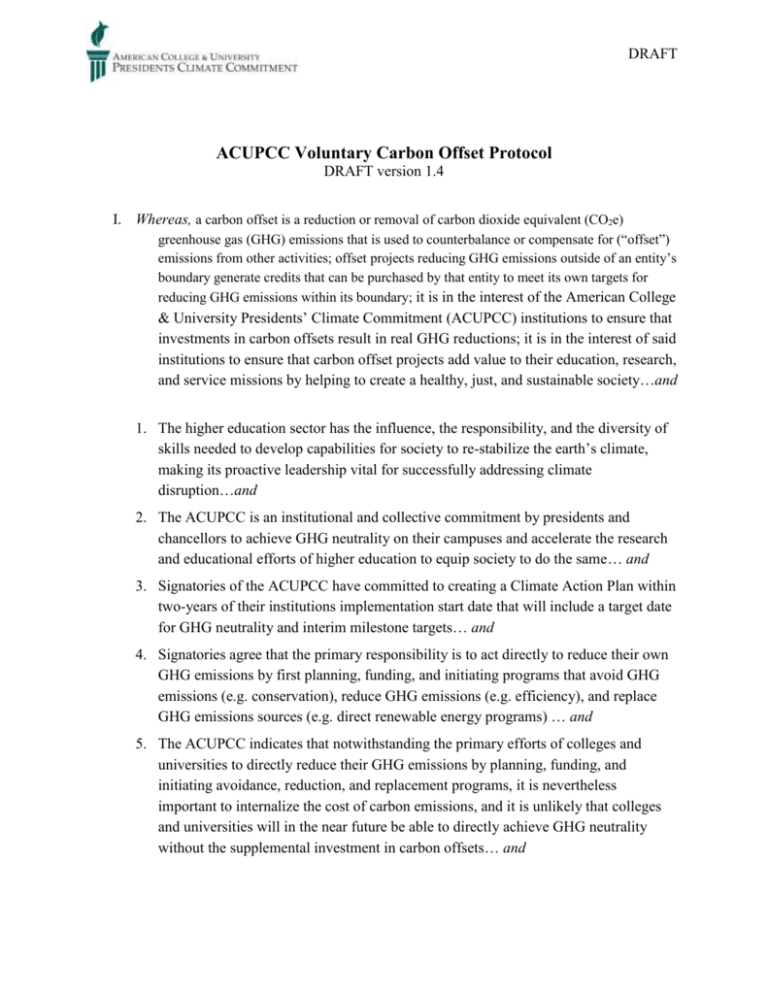
DRAFT ACUPCC Voluntary Carbon Offset Protocol DRAFT version 1.4 I. Whereas, a carbon offset is a reduction or removal of carbon dioxide equivalent (CO2e) greenhouse gas (GHG) emissions that is used to counterbalance or compensate for (“offset”) emissions from other activities; offset projects reducing GHG emissions outside of an entity’s boundary generate credits that can be purchased by that entity to meet its own targets for reducing GHG emissions within its boundary; it is in the interest of the American College & University Presidents’ Climate Commitment (ACUPCC) institutions to ensure that investments in carbon offsets result in real GHG reductions; it is in the interest of said institutions to ensure that carbon offset projects add value to their education, research, and service missions by helping to create a healthy, just, and sustainable society…and 1. The higher education sector has the influence, the responsibility, and the diversity of skills needed to develop capabilities for society to re-stabilize the earth’s climate, making its proactive leadership vital for successfully addressing climate disruption…and 2. The ACUPCC is an institutional and collective commitment by presidents and chancellors to achieve GHG neutrality on their campuses and accelerate the research and educational efforts of higher education to equip society to do the same… and 3. Signatories of the ACUPCC have committed to creating a Climate Action Plan within two-years of their institutions implementation start date that will include a target date for GHG neutrality and interim milestone targets… and 4. Signatories agree that the primary responsibility is to act directly to reduce their own GHG emissions by first planning, funding, and initiating programs that avoid GHG emissions (e.g. conservation), reduce GHG emissions (e.g. efficiency), and replace GHG emissions sources (e.g. direct renewable energy programs) … and 5. The ACUPCC indicates that notwithstanding the primary efforts of colleges and universities to directly reduce their GHG emissions by planning, funding, and initiating avoidance, reduction, and replacement programs, it is nevertheless important to internalize the cost of carbon emissions, and it is unlikely that colleges and universities will in the near future be able to directly achieve GHG neutrality without the supplemental investment in carbon offsets… and DRAFT 6. Signatories may determine investing in offsets, by developing offset projects themselves, investing directly in offset projects, or purchasing credits generated from offset projects, to be an effective way of achieving interim targets and climate neutrality and/or creating a financial incentive for reducing internal emissions… and 7. When done correctly, investment in carbon offsets is scientifically valid and results in the absolute reduction of greenhouse gas emissions to the atmosphere… and II. Therefore, the ACUPCC Institutions have developed a set of guidelines that each will voluntarily apply to any investments in carbon offsets or participation in carbon markets they may undertake as part of their efforts to achieve GHG neutrality, and that will provide guidance for making investments and reducing the risks associated with those investments The guidelines are as follows: 1. Offset projects are real and emissions reductions are additional: Projects result in actual reductions of GHG emissions and would not have otherwise occurred under a reasonable and realistic business-as-usual scenario. 2. Offset projects are transparent: Project details (including project type, location, developer, duration, standard employed, etc.) are known to the institution and communicated to stakeholders in a transparent way to help ensure validity and further the goal of education on climate disruption and sustainability. 3. Emissions reductions are measurable: Projects result in measurable reductions of GHG emissions. 4. Emissions reductions are permanent: Projects result in permanent reductions of GHG emissions. 5. Emissions reductions are verified: Projects result in reductions of GHG emissions that have been verified by an independent third-party auditor that has been evaluated using the accompanying criteria.* 6. Offset projects are synchronous: Projects result in reductions of GHG emissions that take place during a distinct period of time that is reasonably close to the period of time during which the GHG emissions that are being offset took place.* 7. Offset projects account for leakage: Projects take into account any increases in direct or indirect GHG emissions that result from the project activity. 8. Credits are registered: Credits generated from project activities are registered with a well-regarded registry that has been evaluated using the accompanying criteria.* DRAFT 9. Credits are not double-counted: Credits generated from project activities are not double-counted or claimed by any other party.* 10. Credits are retired: Credits are retired before they are claimed to offset an institution’s annual greenhouse gas inventory, or a portion thereof. For more details and guidance on the characteristics of an “independent third-party auditor,” a “reasonably close” time period, “a well-regarded registry,” and strategies for ensuring against double counting, please see the accompanying document to this protocol: Investing in Carbon Offsets: Guidelines for ACUPCC Institutions. *


